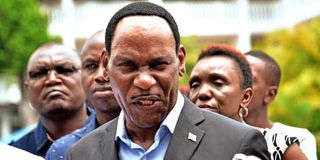KFCB needs support in regulating content

Kenya Film Classification Board chief executive Ezekiel Mutua during an education stakeholders meeting at Travellers Beach Hotel in Mombasa on February 29, 2020.
What you need to know:
- Negative popular art is what states sometimes rely on to fool the citizenry into accepting unpopular and outright evil projects.
- . Addressing gender discrimination and some of Kenya’s recurrent forms of ethnic hatred, therefore, means being honest about popular culture.
- Communal radio stations that target Luo Nyanza are more openly biased against women.
Felicien Kabuga’s arrest in France a few months ago was a major news item across Africa. Hassan Ngeze, his main accomplice in the crime, remains imprisoned in Mali after his 2003 conviction by the then Tanzania-based International Criminal Tribunal for Rwanda.
These two people’s roles in the Rwandan genocide point to a certain relationship between nationhood and popular culture in Africa, which Kenyans should not dismiss.
The bond between art and national identity also recently showed in Ethiopia when Oromo singer Hachalu Hundessa was shot dead. The musician’s killing caused the loss of at least 239 other lives.
These quick and emotive deaths, fuelled by discourses around popular culture, say something about the relevance of the Kenya Film Classification Board (KFCB) and how our popular art represents ethnicity and women in the imagination of nationhood.
Negative popular art is what states sometimes rely on to fool the citizenry into accepting unpopular and outright evil projects. Yet I am in favour of state intervention in cultural productions, even if KFCB’s recent linking of teenage pregnancies in parts of the former Eastern Province to Ukambani popular music was alarmist.
It is hard to not support KFCB’s similar interventions in the past, however controversial they might have been, because enough scholarship shows that Kenyan popular culture is where the national community draws its ideas on how to treat women and other ethnicities. Studies by Mary Muindi, Quin Awuor, Cellyne Anudo, Mbugua Wa-Mungai, Basil Okong’o, Ochieng’ K’Olewe, Henry Omolo and by many other scholars show that Kenyan music is fertile ground for ethnic and gender stereotyping.
Gender discrimination
Many of the traditional perceptions that cause the Kenyan electorate to have only 6.6 per cent of women MCAs, 7.9 per cent of MPs, and 6.4 per cent of senators and governors are manufactured and archived inside popular culture. Addressing gender discrimination and some of Kenya’s recurrent forms of ethnic hatred, therefore, means being honest about popular culture.
This is not to suggest that all popular culture is bad. Popular productions are not the cause of Africa’s civil wars, such as the Radio Television Libre des Mille Collines (RTML) that Felicien Kabuga founded to preach ethnic hatred in Rwanda, and Kangura, the infamous magazine Hassan Ngeze edited for the same purpose. Television, radio, music, newspapers, football and other aspects of popular culture are usually positive agents of nation formation.
But Kenya can testify that popular culture has also often fuelled and hardened racial, ethnic and gender stereotypes. The few scholars who obsess about the beauty of our popular culture have as much right to do so as those who observe that Kenyan singers get arraigned in our courts every election year.
The danger of these stereotypes entering the ears of Kenyan youth is what the KFCB might be referring to when it raises alarm on the state of Kenyan music and its possible connection to teenage pregnancies in parts of Ukambani.
The State body is right because 68 percent of Kenyans and 71 percent of the Kenyan youth listen to local radio stations that are still dominated by patriarchal thinking.
Kenyan communal media are a good example of why KFCB is right that unchecked popular culture reinforces conservative ideologies which order women to shut up.
Radio station slogans alone let you know that communal media were founded to serve male members of respective Kenyan communities. You will hear in the slogan how this or that radio station is the voice of the sons and fathers of a given community.
Gendered backwardness
This gendered backwardness is not just tied to the ethnic gossip that takes over our communal radio stations every night of the electioneering period. It may also be seen in the fact that Joseph Kamaru’s music is almost impossible to hear on benga music programmes in the many communal radio stations that serve both sides of the Lake Victoria gulf, even though the late singer died a benga artiste.
Christopher Monyoncho’s contribution to the benga beat gets edited out of Lake Victoria’s regional benga text. There is always no attempt in these communal radio stations to honour modern ohangla’s roots in Vihiga County by playing John Nzenze and Daudi Kabaka.
It is a masculine definition of Kenyan music in radio stations that combine the two Congos in their analysis of rumba music, roam over Kenya and Tanzania, and then follow rumba’s footprints across the Atlantic Ocean to the Caribbean Islands, and finally stop in Spain.
Our communal popular radio medium kills Kenya’s nationhood by cutting links that promote a national approach to music. Patriarchal ethnic selfishness has ensured that there are no regular programmes that celebrate benga and ohangla music outside their Nyanza birthplace.
Many communal radio stations in Kenya behave this way. If they did not, then it would have been normal to occasionally air Achieng Nyarongo’s or D.O. Misiani’s music on radio stations around the former Central Province. Murang’a is even unique in this regard because its culture is still largely matriarchal, but that is also where many likeable chaps still see election years in Kenya as opportunities to use benga music as a weapon against fellow Kenyans.
Communal radio stations that target Luo Nyanza are more openly biased against women. Female presenters rarely play music by female musicians in genres where women are at par with their male counterparts.
The current circulation of ohangla favours male singers from the old Central Nyanza over South Nyanza’s obvious comparative glitter in regard to the history of Luo music. YouTube ohangla mixes exclude South Nyanza singers. Achieng Nyarongo would be just as well-known as those ohangla singers from Siaya County, were it not that she happens to be a woman from Rongo Town in South Nyanza.
The Kenya Film Classification Board is right that musicians need to guard against artistic language that stereotypes women as inferior.
It has little to do with the ‘morality policing’ we accuse the state body of. KFCB’s mandate will help us avoid some of the obvious weaknesses that Africa knows about popular culture.
Abenea Ndago is a Kenyan writer studying in South Africa




